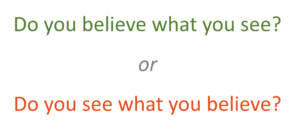28 Aug Confirmation bias clouds our judgment
Confirmation bias is the well-known tendency to selectively attend to information that will reinforce pre-existing beliefs or ideas while ignoring good evidence to the contrary. As Warren Buffet says
‘What the human being is best at doing is interpreting all new information so that their prior conclusions remain intact’.
A synonym for confirmation bias is myside bias, which connotes the deep, personal nature of this particular form of bias. Of the dozen or so biases that can negatively influence our decision-making, the myside type is amongst the most important and insidious.
In this post, I explain why it occurs, the consequences of succumbing, and how to avoid it.
A decision is a course of action you deliberately choose from a number of alternatives to achieve your organisational, managerial or personal objective. The process of decision-making involves consciously or, in the case of routine decisions, subconsciously, [1] identifying your goal, [2] gathering information for evaluating your options, [3] teasing out your options, [4] considering the consequences, [5] making your decision/acting, and [6] subsequently evaluating your decision.
 It’s at stage 2, gathering information, that myside bias comes into play. If the information on which you rely to make a decision is incomplete, distorted, and/or incorrect, it’s easy to understand why the remaining steps will likely be flawed or compromised.
It’s at stage 2, gathering information, that myside bias comes into play. If the information on which you rely to make a decision is incomplete, distorted, and/or incorrect, it’s easy to understand why the remaining steps will likely be flawed or compromised.
Myside bias is more pronounced when there are emotionally charged, ideological or ingrained views, i.e. when difficult decisions are made or the circumstances are unpleasant.
Failing to gather and interpret information in an unbiased way can lead to serious clouding of our judgement, stifle creativity in decision-making, lead to an increased risk of making mistakes with far-reaching and damaging consequences for yourself, others and the organisation.
Furthermore, a single-minded need to enforce your ideas, ‘my way or the highway’ will result in a breakdown of relationships, a failure to build consensus and influence collective decision-making. The reverse is equally powerful. If we recognise this bias and actively manage it then we can dramatically improve our decision-making, relationships and the ability to influence others. Costly, irretrievable mistakes will be avoided and innovation and sound judgement fostered.
Why we fall prey to myside bias
We see data that reinforces our worldview and we take this confirmatory data as given, as accurate, i.e. we say to ourselves I already know that. We treat it as the truth. It’s also easier because it requires less mental energy, less time. We can move on quickly to the next competing demand. At the same time, we ignore, or threat contradictory information with scepticism or simply reject it out of hand. We then don’t have to devote time or energy to process and deal with it.
The reason we are susceptible to this bias lies in our need for cognitive consistency especially when evidence is new, complicated or unclear. This cognitive shortcut promotes efficiency especially under pressure to decide, to make complex choices with trade-offs and to act in short turnaround times.
We are bombarded by information 24/7/365 and our minds must encode, store and retrieve the data to which we are exposed. Our mechanisms for coping under these circumstances include taking these cognitive shortcuts and using established mental models or patterns of thinking. It is in part a survival strategy. However, we need to recognise when we should build in time to surface assumptions, test the validity of our evidence, and actively seek out dis-confirmatory data or we risk the pitfalls described above.
Avoiding myside bias
As a leader, you are required to make decisions where complexity, uncertainty, high stakes and time-pressure prevail. These situations heighten the risk of myside bias influencing your decisions.
You need to work actively to avoid falling into the myside bias trap.
Here are my tips:
-
- Recognise that you, like all of us, are prone to myside bias for the reasons stated above.
- Actively seek out different views from those who are not like you. Be open to hearing them.
- Say to trusted others “I need another perspective, so please tell me what you think I should do…”
- Suspend your judgement. Give yourself space. Say, “I’ll think about it and get back to you”. Do not make snap important decisions, unless it is an emergency.
- Test yourself. “What would happen if I did nothing?” Or “If I did the opposite of what I would normally do?”
- Search out disconfirming evidence and take the time to list all the reasons you should not make the decision.
In the final analysis, as a leader you should always be aware of the tendency to take the easy path and interpret information in a way that leaves your prior beliefs intact.
As Robertson Davies wrote, The eye sees only what the mind is prepared to comprehend.
More on confirmation bias
You might like to read ‘The little book of stupidity: How we lie to ourselves and don’t believe others’
And these posts


